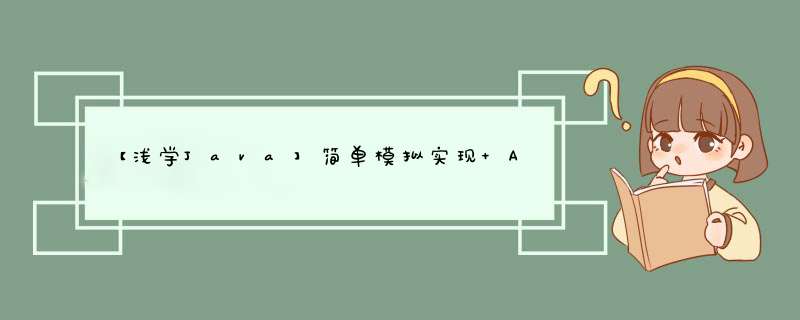
想要用好Java中的提供的ArrayList,你就得十分熟悉ArrayList的原理,通过模拟实现ArrayList,就可以为以后阅读ArrayList源码打下基础,从而为熟悉ArrayList底层原理打下基础。
下面我们先来简单分析一下以下接口的实现细节:
public class MyArrayList {
public int []elem;//设置数组
public int usedSize;//设置下标
private static final int DEFAULT_SIZE=10;//设置数组的默认大小
//设置一个构造方法
public MyArrayList() {
this.elem = new int[DEFAULT_SIZE];
this.usedSize = 0;
}
// 打印顺序表
public void display() {
直接遍历即可
}
// 新增元素,默认在数组最后新增
public void add(int data) {
1.判断数组是否满了
2.满了就进行扩容,不满就进行插入 *** 作
}
// 在 pos 位置新增元素
public void add(int pos, int data) {
1.判断pos的合理性,不合理就扔出异常(程序停下来)
2.判断数组是否满了,满了就进行扩容
3.进行插入 *** 作
}
// 判定是否包含某个元素
public boolean contains(int toFind) {
遍历数组,找到返回true,没有找到就返回false
}
// 查找某个元素对应的位置
public int indexOf(int toFind) {
遍历数组,找到就返回数组下标,没有找到就返回-1
return -1;
}
// 获取 pos 位置的元素
public int get(int pos) {
1.判断数组是否为空,为空就扔出"数组为空"的异常
2.判断pos的合理性,不合理就扔出异常;
3.前两步都没有问题时就返回pos位置的值
}
// 给 pos 位置的元素设为 value————注意,这里不会给顺序表添加元素
public void set(int pos, int value) {
1.检查数组是否为空,为空就扔出"数组为空"的异常
2.判断pos的合理性,不合理就扔出异常;
3.前两步都没有问题时,就将pos 位置的元素设为 value
}
//删除第一次出现的关键字key
public void remove(int toRemove) {
1.检查数组是否为空,为空就扔出"数组为空"的异常
2.第一步没问题,遍历数组找到值为toRemove的下标,然后就进行删除 *** 作
}
// 获取顺序表长度
public int size() {
直接return usedSize
}
// 清空顺序表
public void clear() {
直接将usedSize置为0
}
}
大家可以参照上面的思路实现一遍,然后再来看下面的代码:
public class MyArrayList {
public int []elem;
public int usedSize;
private static final int DEFAULT_SIZE=10;
public MyArrayList() {
this.elem = new int[DEFAULT_SIZE];
this.usedSize = 0;
}
//判断数组是否满了
public boolean isFull(){
return this.elem.length==this.usedSize;
}
private boolean checkPos(int pos){
if(pos<0||pos>this.usedSize){
System.out.println("pos位置不合法");
return false;
}
return true;
}
private boolean isEmpty(){
return this.usedSize==0;
}
//打印顺序表
public void display() {
for(int i=0;i<this.usedSize;i++){
System.out.printf("%d ",this.elem[i]);
}
System.out.println();
}
// 新增元素,默认在数组最后新增
public void add(int data) {
//判断是否满了,如果满了就进行扩容
if(isFull()){
this.elem=Arrays.copyOf(this.elem,2*this.elem.length);
}
//不满就进行插入
this.elem[this.usedSize]=data;
this.usedSize++;
}
// 在 pos 位置新增元素
public void add(int pos, int data) {
if(!checkPos(pos)){
throw new MyArrayListIndexOutOfException("添加方法的pos不合理");
}
if(isFull()){
//数组满了,就扩容
this.elem=Arrays.copyOf(this.elem,2*this.elem.length);
}
for(int i=this.usedSize-1;i>=pos;i--){
this.elem[i+1]=elem[i];
}
this.elem[pos]=data;
this.usedSize++;
}
// 判定是否包含某个元素
public boolean contains(int toFind) {
for(int i=0;i<this.usedSize;i++){
if(toFind==this.elem[i]){
return true;
}
}
return false;
}
// 查找某个元素对应的位置
public int indexOf(int toFind) {
for(int i=0;i<this.usedSize;i++){
if(toFind==this.elem[i]){
return i;
}
}
return -1;
}
// 获取 pos 位置的元素
public int get(int pos) {
if(!checkPos(pos)){
throw new MyArrayListIndexOutOfException("pos位置不合理");
}
if(isEmpty()){
throw new MyArrayListEmptyException("获取元素时,顺序表为空");
}
return this.elem[pos];
}
// 给 pos 位置的元素设为 value
public void set(int pos, int value) {
if(!checkPos(pos)){
throw new MyArrayListIndexOutOfException("pos位置不合理");
}
if(isEmpty()){
throw new MyArrayListIndexOutOfException("顺序表为空");
}
this.elem[pos]=value;
}
//删除第一次出现的关键字key
public void remove(int toRemove) {
if(isEmpty()){
throw new MyArrayListIndexOutOfException("顺序表为空");
}
for(int i=0;i<this.usedSize;i++){
if(toRemove==this.elem[i]){
for(int j=i;j<this.usedSize-1;j++){
this.elem[j]=this.elem[j+1];
}
this.usedSize--;
return;
}
}
System.out.println("不存在你要删除的数据");
}
// 获取顺序表长度
public int size() {
return this.usedSize;
}
// 清空顺序表
public void clear() {
this.usedSize=0;
System.out.println("顺序表已清空");
}
}
下面来进行一些测试 *** 作:
public class TestDemo {
public static void main(String[] args) {
MyArrayList myArrayList=new MyArrayList();//实例化MyArrayList对象啊
for(int i=0;i<10;i++){
myArrayList.add(i);//先在顺序表中插入一些数据
}
myArrayList.display();//打印顺序表
System.out.println("===================");
boolean ret1= myArrayList.contains(9);//查看9是否在顺序表中
System.out.println(ret1);
System.out.println("===================");
int ret2=myArrayList.indexOf(6);//查看6在顺序表中的下标位置
System.out.println(ret2);
System.out.println("===================");
int ret3=myArrayList.get(5);//获取下标为5位置处的值
System.out.println(ret3);
System.out.println("===================");
myArrayList.set(0,999);//把0下标的值置为999
myArrayList.display();
System.out.println("===================");
myArrayList.remove(4);//删除第一次出现的4
myArrayList.display();
System.out.println("===================");
int len=myArrayList.usedSize;//获取顺序表长度
System.out.println(len);
System.out.println("===================");
myArrayList.clear();//清空顺序表
myArrayList.display();
System.out.println("===================");
}
}
上面基本模拟了ArrayList的基本 *** 作,想要进一步学习ArrayList,请看下一篇文章~~
欢迎分享,转载请注明来源:内存溢出

 微信扫一扫
微信扫一扫
 支付宝扫一扫
支付宝扫一扫
评论列表(0条)